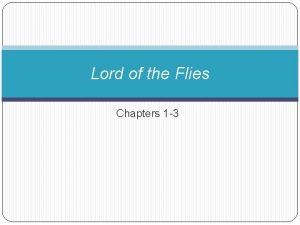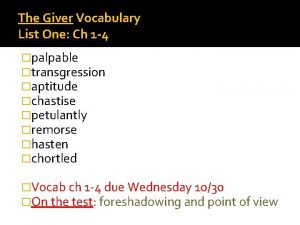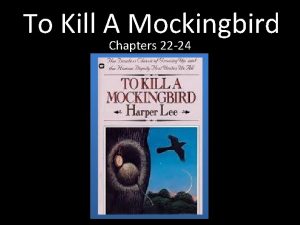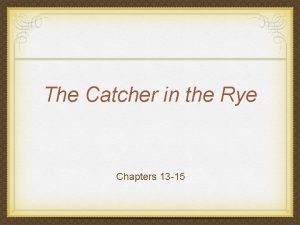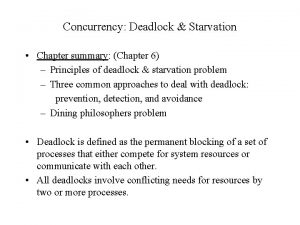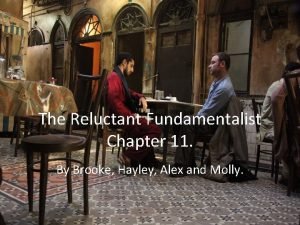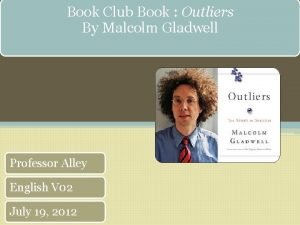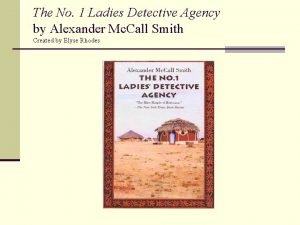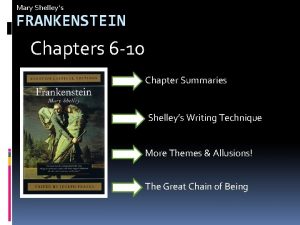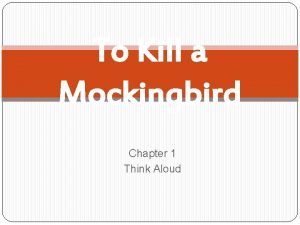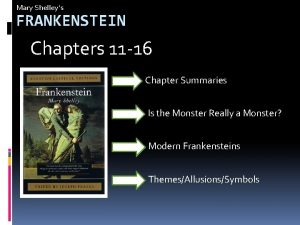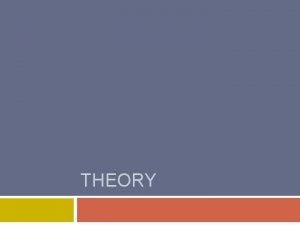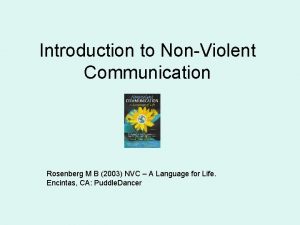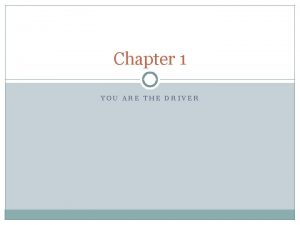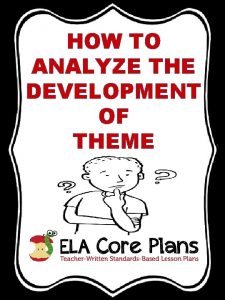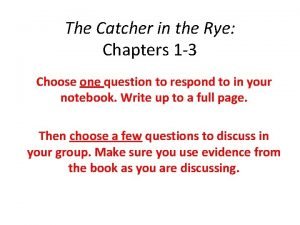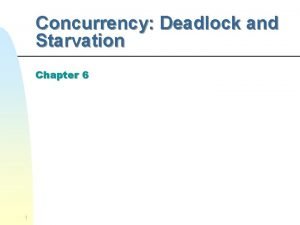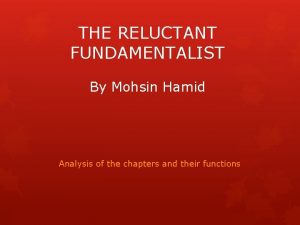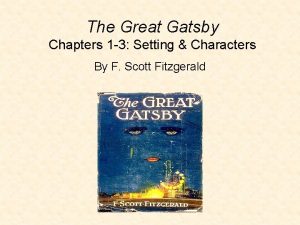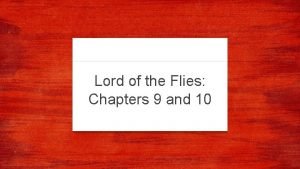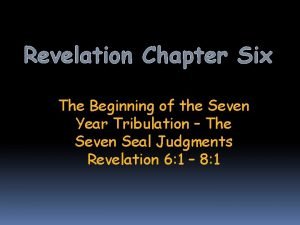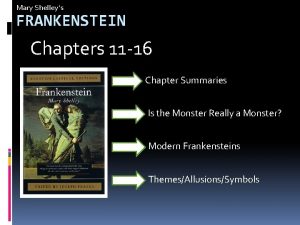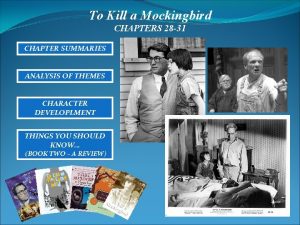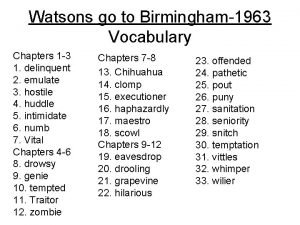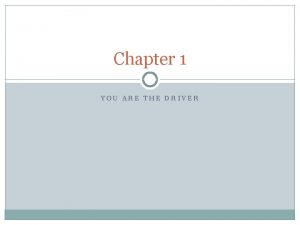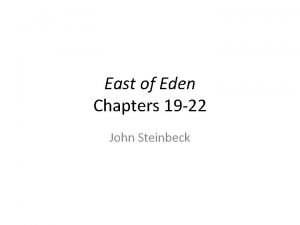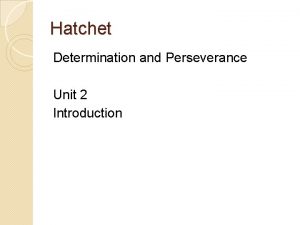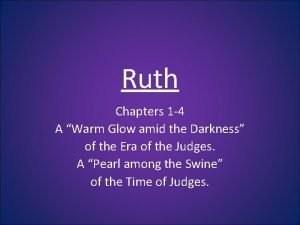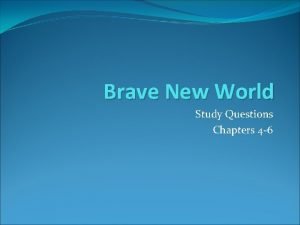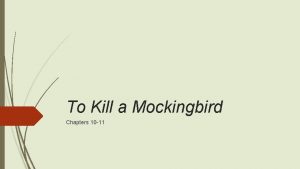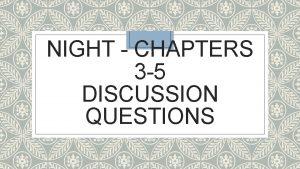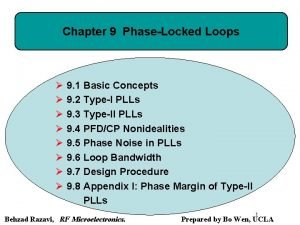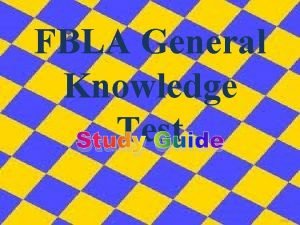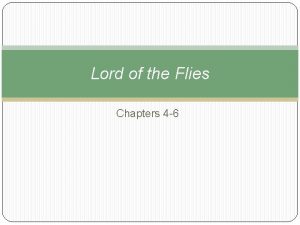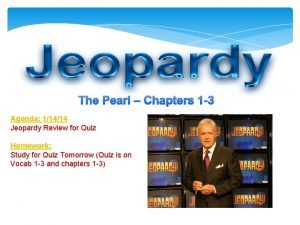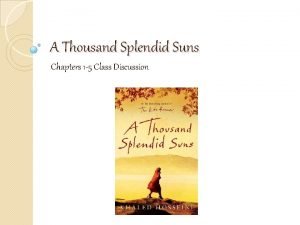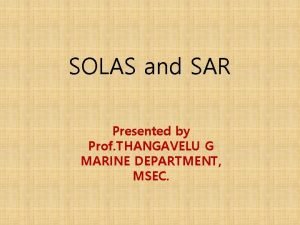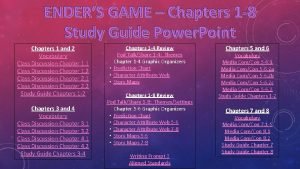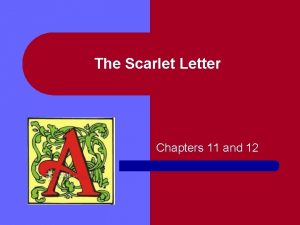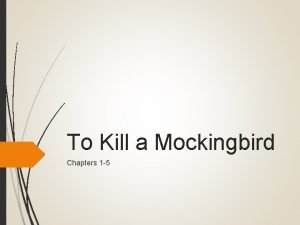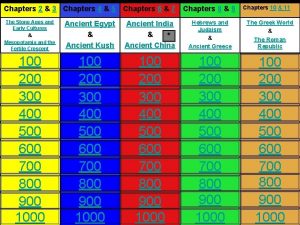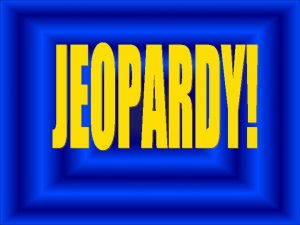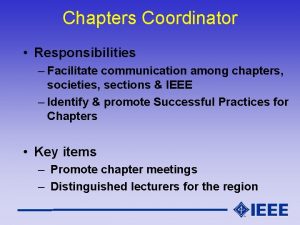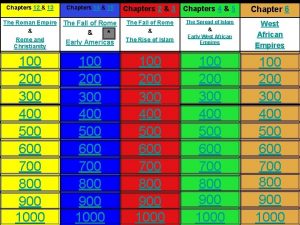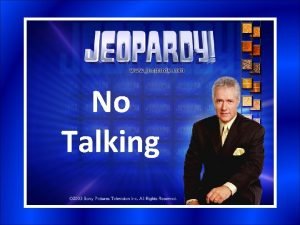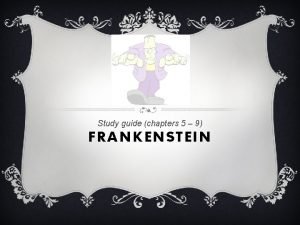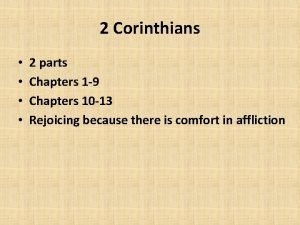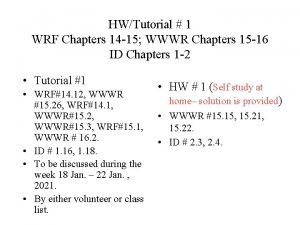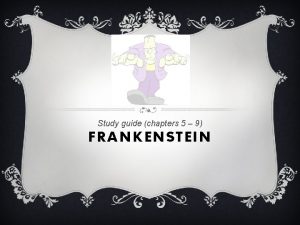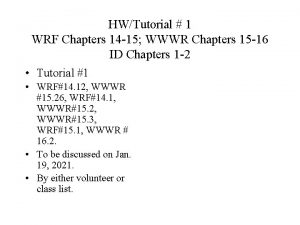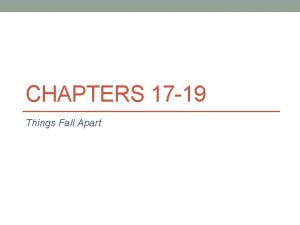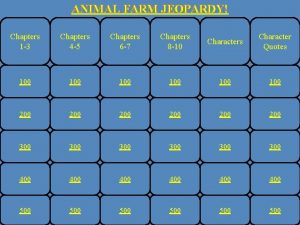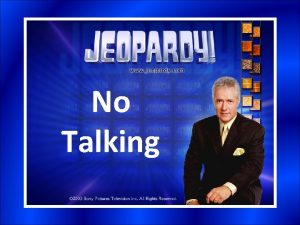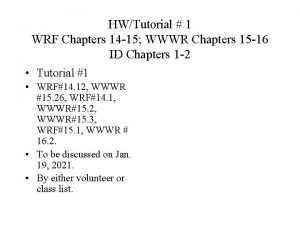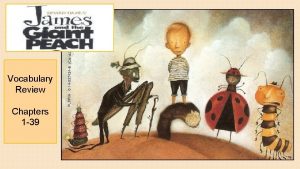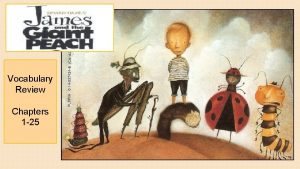Chapters 2 3 Chapters 4 5 Chapters 6


























































































































- Slides: 122

Chapters 2 & 3 Chapters 4 & 5 Chapters 6 & 7 Chapters 8 & 9 Chapters 10 & 11 The Stone Ages and Early Cultures & Mesopotamia and the Fertile Crescent Ancient Egypt & Ancient Kush Ancient India & * Ancient China Hebrews and Judaism & Ancient Greece The Greek World & The Roman Republic 100 200 300 400 500 600 700 800 900 1000 100 200 300 400 500 600 700 800 900 1000

G 6 Chapter 2 The Stone Ages and Early Cultures (5 Million Years Ago – 5, 000 Years)

G 6 C 3 Mesopotamia and the Fertile Crescent (7, 000 – 500 BC)

G 6 C 2 Key Terms and People 1. 2. 3. 4. 5. 6. 7. 8. 9. 10. 11. 12. 13. 14. 15. prehistory hominid ancestor tool Paleolithic Era society hunter-gatheres migrate ice ages land bridge Mesolithic Era Neolithic Era domestication agriculture megaliths Academic Vocabulary

G 6 C 3 Key Terms and People 1. 2. 3. 4. 5. 6. 7. 8. 9. 10. 11. 12. 13. 14. 15. Fertile Crescent silt irrigation canals surplus division of labor rural urban city-state Gilgamesh Sargon empire poltytheism priests social hierarchy 16. 17. 18. 19. 20. 21. 22. 23. 24. 25. 26. cuneiform pictographs scribe epics architecture ziggurat monarch Hammurabi’s Code chariot Nebuchadnezzar alphabet

100 Answer the process of changing plants or animals to make them more useful to humans 1. 2. 3. 4. 5. 6. 7. Stone Age Hunter-Gatheres Ice Ages Early Human Migration A Mammoth House Early Domestication Stone Tools 8. The Fertile Crescent 9. Cuneiform 10. Irrigation and Civilization 11. Polytheism 12. The Wheel 13. Hammurabi’s Code 14. The Assyrian Army

200 Answer The Sumerians believed in many gods. 1. 2. 3. 4. 5. 6. 7. Stone Age Hunter-Gatheres Ice Ages Early Human Migration A Mammoth House Early Domestication Stone Tools 8. The Fertile Crescent 9. Cuneiform 10. Irrigation and Civilization 11. Polytheism 12. The Wheel 13. Hammurabi’s Code 14. The Assyrian Army

300 Answer Do you realize how much the achievements of ancient Sumer affect your life today—and every day? For instance, try to imagine life without _____. How would you get around? Look at the streets outside. The cars, trucks, and buses you see are all modern versions of Sumerian ______ (ed) vehicles. bicycles, and in-line skates all depend on ____ as well. Even modern air travel owes a large debt to the Sumerians. As impressive as jets are, they could never get off the ground without _____! 1. 2. 3. 4. 5. 6. 7. Stone Age Hunter-Gatheres Ice Ages Early Human Migration A Mammoth House Early Domestication Stone Tools 8. The Fertile Crescent 9. Cuneiform 10. Irrigation and Civilization 11. Polytheism 12. The Wheel 13. Hammurabi’s Code 14. The Assyrian Army

400 Answer an area of rich farmland in Southwest Asia where the first civilizations began 1. 2. 3. 4. 5. 6. 7. Stone Age Hunter-Gatheres Ice Ages Early Human Migration A Mammoth House Early Domestication Stone Tools 8. The Fertile Crescent 9. Cuneiform 10. Irrigation and Civilization 11. Polytheism 12. The Wheel 13. Hammurabi’s Code 14. The Assyrian Army

500 Answer This was a set of 282 laws that dealt with almost every part of daily life. There were laws on everything from trade, loans, and theft to marriage, injury, and murder. It contained some ideas that are still found in laws today. Specific crimes brought specific penalties. However, social class did matter. For instance, injuring a rich man brought a greater penalty than injuring a poor man. 1. 2. 3. 4. 5. 6. 7. Stone Age Hunter-Gatheres Ice Ages Early Human Migration A Mammoth House Early Domestication Stone Tools 8. The Fertile Crescent 9. Cuneiform 10. Irrigation and Civilization 11. Polytheism 12. The Wheel 13. Hammurabi’s Code 14. The Assyrian Army

600 Answer They hunted animals and gathered wild plants to survive. Life for these _______ was difficult and dangerous. Still, people learned how to make tools, use fire, and even create art. Anthropologists believe that most Stone Age hunters were men. They hunted in groups, sometimes chasing entire herds of animals over cliffs. This method was both more productive and safer than hunting alone. 1. 2. 3. 4. 5. 6. 7. Stone Age Hunter-Gatheres Ice Ages Early Human Migration A Mammoth House Early Domestication Stone Tools 8. The Fertile Crescent 9. Cuneiform 10. Irrigation and Civilization 11. Polytheism 12. The Wheel 13. Hammurabi’s Code 14. The Assyrian Army

700 Answer This was the world’s first system of writing. Sumerians did not have pencils, pens, or paper. Instead, they used sharp tools called styluses to make wedge-shaped symbols on clay tablets. 1. 2. 3. 4. 5. 6. 7. Stone Age Hunter-Gatheres Ice Ages Early Human Migration A Mammoth House Early Domestication Stone Tools 8. The Fertile Crescent 9. Cuneiform 10. Irrigation and Civilization 11. Polytheism 12. The Wheel 13. Hammurabi’s Code 14. The Assyrian Army

800 Answer This was the most powerful fighting force the world had ever seen. It was large and well organized, and it featured iron weapons, war chariots, and giant war machines used to knock down city walls. 1. 2. 3. 4. 5. 6. 7. Stone Age Hunter-Gatheres Ice Ages Early Human Migration A Mammoth House Early Domestication Stone Tools 8. The Fertile Crescent 9. Cuneiform 10. Irrigation and Civilization 11. Polytheism 12. The Wheel 13. Hammurabi’s Code 14. The Assyrian Army

900 Answer Since the area of Southwest Asia received little rain, water needed to be transferred from the rivers to inland areas to grow food. People began to dig canals to bring water inland. With controlling the water supply, civilizations developed with the increase in the production of food. 1. 2. 3. 4. 5. 6. 7. Stone Age Hunter-Gatheres Ice Ages Early Human Migration A Mammoth House Early Domestication Stone Tools 8. The Fertile Crescent 9. Cuneiform 10. Irrigation and Civilization 11. Polytheism 12. The Wheel 13. Hammurabi’s Code 14. The Assyrian Army

1000 Answer The origin of man is believed to have started in Africa. As the climate changed, people began leaving Africa and migrated to other parts of the world. 1. 2. 3. 4. 5. 6. 7. Stone Age Hunter-Gatheres Ice Ages Early Human Migration A Mammoth House Early Domestication Stone Tools 8. The Fertile Crescent 9. Cuneiform 10. Irrigation and Civilization 11. Polytheism 12. The Wheel 13. Hammurabi’s Code 14. The Assyrian Army

Chapter 4 Ancient Egypt (4500 – 500 BC)

Chapter 5 Ancient Kush (c. 2300 BC - AD 350)

G 6 C 4 Key Terms and People 1. 2. 3. 4. 5. 6. 7. 8. 9. 10. 11. 12. 13. 14. 15. cataracts Menes pharaoh dynasty Old Kingdom Khufu nobles afterlife mummies elite pyramids engineering Middle Kingdom New Kingdom trade routes 16. Queen Hatshepsut 17. Ramses the Great 18. heiroglyphics 19. papyrus 20. Rosetta Stone 21. sphinxes 22. obelisk 23. King Tutankamen

G 6 C 5 Key Terms and People 1. 2. 3. 4. 5. 6. 7. 8. 9. ebony ivory Piankhi trade network merchants exports imports Queen Shanakhdakheto King Ezana

100 Answer (ruled c. 1503– 1482 BC) Egyptian queen, she worked to increase trade with places outside of Egypt and ordered many impressive monuments and temples built during her reign. 1. 2. 3. 4. 5. 6. 7. Ancient Egypt and the Nile River 8. Ebony Egyptian Society 9. Ivory Queen Hatshepsut 10. Exports Ramses the Great 11. Imports Heiroglyphics 12. Kush’s Trade Network Egyptian Gods 13. Kushite Metalwork Mummies and the Afterlife 14. Decline and Defeat of Kushite Kingdom

200 1. 2. 3. 4. 5. 6. 7. Answer The ancient Egyptian writing system that used picture symbols. The writing was done on papyrus, a long-lasting, paper-like material made from reeds that the ancient Egyptians used to wrote on. The Egyptians made papyrus by pressing layers of reeds together and pounding them into sheets. These sheets were tough and durable, yet easy to roll into scrolls. Scribes wrote on papyrus using brushes and ink. Ancient Egypt and the Nile River 8. Ebony Egyptian Society 9. Ivory Queen Hatshepsut 10. Exports Ramses the Great 11. Imports Heiroglyphics 12. Kush’s Trade Network Egyptian Gods 13. Kushite Metalwork Mummies and the Afterlife 14. Decline and Defeat of Kushite Kingdom

300 Answer a white material made from elephant tusks. 1. 2. 3. 4. 5. 6. 7. Ancient Egypt and the Nile River 8. Ebony Egyptian Society 9. Ivory Queen Hatshepsut 10. Exports Ramses the Great 11. Imports Heiroglyphics 12. Kush’s Trade Network Egyptian Gods 13. Kushite Metalwork Mummies and the Afterlife 14. Decline and Defeat of Kushite Kingdom

400 Answer (late 1300 s and early 1200 s BC) Many people consider ______ the last great Egyptian pharaoh. He accomplished great things, but the pharaohs who followed could not maintain them. Both a great warrior and a great builder, he is known largely for the massive monuments he built. The temples at Karnak, Luxor, and Abu Simbel stand as 3, 000 -year 1. Ancient Egypt and the Nile River 8. Ebony 2. Egyptian Society 9. Ivory old symbols of the great pharaoh’s power. 3. 4. 5. 6. 7. Queen Hatshepsut Ramses the Great Heiroglyphics Egyptian Gods Mummies and the Afterlife 10. Exports 11. Imports 12. Kush’s Trade Network 13. Kushite Metalwork 14. Decline and Defeat of Kushite Kingdom

500 Answer items sent to other regions for trade 1. 2. 3. 4. 5. 6. 7. Ancient Egypt and the Nile River 8. Ebony Egyptian Society 9. Ivory Queen Hatshepsut 10. Exports Ramses the Great 11. Imports Heiroglyphics 12. Kush’s Trade Network Egyptian Gods 13. Kushite Metalwork Mummies and the Afterlife 14. Decline and Defeat of Kushite Kingdom

600 Answer goods brought in from other regions 1. 2. 3. 4. 5. 6. 7. Ancient Egypt and the Nile River 8. Ebony Egyptian Society 9. Ivory Queen Hatshepsut 10. Exports Ramses the Great 11. Imports Heiroglyphics 12. Kush’s Trade Network Egyptian Gods 13. Kushite Metalwork Mummies and the Afterlife 14. Decline and Defeat of Kushite Kingdom

700 Answer (Most powerful to least powerful). Pharaoh – ruled Egypt as a God; Nobles – ran government and temples (from powerful and rich families); Scribes and Craftspeople – wrote and produced goods; Farmers, Servants, and Slaves – did all manual labor in the growing fields and building the pyramids. 1. 2. 3. 4. 5. 6. 7. Ancient Egypt and the Nile River 8. Ebony Egyptian Society 9. Ivory Queen Hatshepsut 10. Exports Ramses the Great 11. Imports Heiroglyphics 12. Kush’s Trade Network Egyptian Gods 13. Kushite Metalwork Mummies and the Afterlife 14. Decline and Defeat of Kushite Kingdom

800 Answer a type of dark, heavy wood 1. 2. 3. 4. 5. 6. 7. Ancient Egypt and the Nile River 8. Ebony Egyptian Society 9. Ivory Queen Hatshepsut 10. Exports Ramses the Great 11. Imports Heiroglyphics 12. Kush’s Trade Network Egyptian Gods 13. Kushite Metalwork Mummies and the Afterlife 14. Decline and Defeat of Kushite Kingdom

900 Answer Ancient Kush was at the center of a large trading network with connections to Europe, Africa, and Asia. Kush’s location and production of iron goods helped make it a rich trading center. 1. 2. 3. 4. 5. 6. 7. Ancient Egypt and the Nile River 8. Ebony Egyptian Society 9. Ivory Queen Hatshepsut 10. Exports Ramses the Great 11. Imports Heiroglyphics 12. Kush’s Trade Network Egyptian Gods 13. Kushite Metalwork Mummies and the Afterlife 14. Decline and Defeat of Kushite Kingdom

1000 Answer Geography played a key role in the development of Egyptian civilization. The Nile River brought life to Egypt and allowed it to thrive. The river was so important to people in this region that a Greek historian named Herodotus (hi-RAHD-uhtuhs) called Egypt the gift of the Nile. 1. 2. 3. 4. 5. 6. 7. Ancient Egypt and the Nile River 8. Ebony Egyptian Society 9. Ivory Queen Hatshepsut 10. Exports Ramses the Great 11. Imports Heiroglyphics 12. Kush’s Trade Network Egyptian Gods 13. Kushite Metalwork Mummies and the Afterlife 14. Decline and Defeat of Kushite Kingdom

G 6 C 6 Ancient India (2, 300 BC – AD 500)

G 6 C 7 Ancient China (1600 BC - AD 1)

G 6 C 6 Key Terms and People 1. 2. 3. 4. 5. 6. 7. 8. 9. 10. 11. 12. 13. 14. 15. subcontinent monsoons Sanskirt caste system Hinduism reincarnation karma Jainism nonviolence fasting meditation the Buddha Buddhism nirvana missionaries 16. Chandragupta Maurya 17. Asoka 18. Chandragupta II 19. metallurgy 20. alloys 21. Hindu-Arabic numerals 22. inoculation 23. astronomy

G 6 C 7 Key Terms and People 1. Jade 2. oracle 3. Lords 4. peasants 5. Confucius 6. ethics 7. Confucianism 8. Daoism 9. Laozi 10. Legalism 11. Shi Huangdi 12. Great Wall 13. sundai 14. seismograph 15. acupuncture 16. 17. 18. silk Silk Road diffusion

100 Answer Founder of the ideas of Buddhism. Also, known as the Buddha. 1. 2. 3. 4. 5. 6. 7. Indus River Indian Society Major Beliefs in Hinduism Caste System Siddhartha Gautama Buddhism Asoka 8. Huang He 9. Shang Dynasty 10. Zhou Dynasty 11. The Warring States Period 12. Confucius 13. Confucianism 14. The Silk Road

200 Answer It is located in northern China and is known as the Yellow River. It has long been the center of civilization. The silt in the river gives it a yellow look. Southern China receives more rain than northern China, and farmers can grow several crops of rice a year. Western China’s high mountains and wide deserts make travel difficult and isolate China’s population centers in the east. 1. 2. 3. 4. 5. 6. 7. Indus River Indian Society Major Beliefs in Hinduism Caste System Siddhartha Gautama Buddhism Asoka 8. Huang He 9. Shang Dynasty 10. Zhou Dynasty 11. The Warring States Period 12. Confucius 13. Confucianism 14. The Silk Road

300 Answer (551 -479 BC) He was the most influential teacher in Chinese history. He grew up in extreme poverty. He was a dedicated student into his teenage years. Little is known about how he received his formal education, but he mastered many subjects, including music, mathematics, poetry, and history. He served in minor government positions, then he became a teacher. He never knew his teachings would transform Chinese life and thought. 1. 2. 3. 4. 5. 6. 7. Indus River Indian Society Major Beliefs in Hinduism Caste System Siddhartha Gautama Buddhism Asoka 8. Huang He 9. Shang Dynasty 10. Zhou Dynasty 11. The Warring States Period 12. Confucius 13. Confucianism 14. The Silk Road

400 Answer This has divided people into groups based on wealth and status. People lived their lives by associating with only others of the same level of society. 1. 2. 3. 4. 5. 6. 7. Indus River Indian Society Major Beliefs in Hinduism Caste System Siddhartha Gautama Buddhism Asoka 8. Huang He 9. Shang Dynasty 10. Zhou Dynasty 11. The Warring States Period 12. Confucius 13. Confucianism 14. The Silk Road

500 Answer The first dynasty for which we have clear evidence. It was firmly established by the 1500 s BC. Strongest in the Huang He Valley, the _____ ruled a broad area of northern China. Their rulers moved their capital several times, probably to avoid floods or attack by enemies. 1. 2. 3. 4. 5. 6. 7. Indus River Indian Society Major Beliefs in Hinduism Caste System Siddhartha Gautama Buddhism Asoka 8. Huang He 9. Shang Dynasty 10. Zhou Dynasty 11. The Warring States Period 12. Confucius 13. Confucianism 14. The Silk Road

600 Answer The Harappan civilization grew as irrigation and agriculture improved along this river. As farmers began to produce surpluses of food, towns and cities appeared in India. 1. 2. 3. 4. 5. 6. 7. Indus River Indian Society Major Beliefs in Hinduism Caste System Siddhartha Gautama Buddhism Asoka 8. Huang He 9. Shang Dynasty 10. Zhou Dynasty 11. The Warring States Period 12. Confucius 13. Confucianism 14. The Silk Road

700 Answer Brahmins (BRAH-muhns), or priests, Kshatriyas (KSHA-tree-uhs), or rulers and warriors, Vaisyas (VYSH-yuhs), or farmers, craftspeople, and traders, and Sudras (SOO-drahs), or laborers and non-Aryans. The Brahmins were seen as the highest ranking because they performed rituals for the gods. This gave the Brahmins great influence over the other varnas. 1. 2. 3. 4. 5. 6. 7. Indus River Indian Society Major Beliefs in Hinduism Caste System Siddhartha Gautama Buddhism Asoka 8. Huang He 9. Shang Dynasty 10. Zhou Dynasty 11. The Warring States Period 12. Confucius 13. Confucianism 14. The Silk Road

800 Answer 1. A universal spirit called Brahman created the universe and everything in it. Everything in the world is just part of Braham. 2. Every person has a soul or atman that will eventually join with the Brahman. 3. People’s souls are reincarnated many times before they can join with Brahman. 4. A person’s karma affects how her or she will be reincarnated. 1. 2. 3. 4. 5. 6. 7. Indus River Indian Society Major Beliefs in Hinduism Caste System Siddhartha Gautama Buddhism Asoka 8. Huang He 9. Shang Dynasty 10. Zhou Dynasty 11. The Warring States Period 12. Confucius 13. Confucianism 14. The Silk Road

900 Answer 1. People should be respected and loyal to their family members 2. Leaders should be kind and lead by example. 3. Learning is a process that never ends. 4. Heaven expects people to behave well and act morally. 1. 2. 3. 4. 5. 6. 7. Indus River Indian Society Major Beliefs in Hinduism Caste System Siddhartha Gautama Buddhism Asoka 8. Huang He 9. Shang Dynasty 10. Zhou Dynasty 11. The Warring States Period 12. Confucius 13. Confucianism 14. The Silk Road

1000 Answer 1. Suffering and unhappiness are a part of human life. No one can escape sorrow. 2. Suffering comes from our desires for pleasure and material goods. People cause their own misery because they want things they cannot have. 3. People can overcome desire and ignorance and reach nirvana (nir-VAH-nuh), a state of perfect peace. Reaching nirvana frees the soul from suffering and from the need for further reincarnation. 4. People can overcome ignorance and desire by following an eightfold path that leads to wisdom, enlightenment, and salvation. 1. 2. 3. 4. 5. 6. 7. Indus River Indian Society Major Beliefs in Hinduism Caste System Siddhartha Gautama Buddhism Asoka 8. Huang He 9. Shang Dynasty 10. Zhou Dynasty 11. The Warring States Period 12. Confucius 13. Confucianism 14. The Silk Road

Chapter 8 Hebrews and Judaism (2000 BC - AD 70)

Chapter 9 Ancient Greece (2000 BC – 500 BC)

G 6 C 8 Key Terms and People 1. Abraham 2. Moses 3. Exodus 4. Ten Commandments 5. David 6. Solomon 7. Diaspora 8. Judaism 9. monothesim 10. Torah 11. synagogue 12. prophets 13. Talmud 14. Dead Sea Scrolls 15. Zealots 16. Rabbis 17. Passover 18. High Holy Days

G 6 C 9 Key Terms and People 1. 2. 3. 4. 5. 6. 7. 8. 9. 10. 11. 12. 13. 14. Polis classical acropolis democracy aristocrats oligarchy citizens tyrant Pericles mythology Homer Sappho Aesop fables

100 Answer This is the most sacred of Hebrew writings. Jews believe its contents were revealed to Moses by God. It plays a central role in many Jewish ceremonies, like this one. 1. 2. 3. 4. 5. 6. 7. Abraham Moses Judaism and Monotheism The Torah Jewish Migration after AD 70 Ten Commandments The Dead Sea Scrolls 8. Aristocrats 9. Tyrants 10. Democracy in Action 11. Democracy Then and Now 12. Homer and Epic Poetry 13. Aesop and Fables 14. Greek Influence on Language

200 Answer (c. 1200 s BC) Biblical figure, according to the Bible, he led the Hebrew people out of Egypt and back to Canaan in the Exodus. During this journey, he received the Ten Commandments from God. 1. 2. 3. 4. 5. 6. 7. Abraham Moses Judaism and Monotheism The Torah Jewish Migration after AD 70 Ten Commandments The Dead Sea Scrolls 8. Aristocrats 9. Tyrants 10. Democracy in Action 11. Democracy Then and Now 12. Homer and Epic Poetry 13. Aesop and Fables 14. Greek Influence on Language

300 Answer These are short stories that teach the reader lessons about life or give advice on how to live. 1. 2. 3. 4. 5. 6. 7. Abraham Moses Judaism and Monotheism The Torah Jewish Migration after AD 70 Ten Commandments The Dead Sea Scrolls 8. Aristocrats 9. Tyrants 10. Democracy in Action 11. Democracy Then and Now 12. Homer and Epic Poetry 13. Aesop and Fables 14. Greek Influence on Language

400 Answer According to the Hebrew Bible, God told _______ to leave his home in Mesopotamia. He was to take his family on a long journey to the west. God promised to lead ______ to a new land make his descendants into a mighty nation. _______left Mesopotamia and settled in Canaan (KAYnuhn), on the Mediterranean Sea. His descendants—the Hebrews—lived in Canaan for many years. Later, however, some Hebrews moved to Egypt, perhaps because of famine in Canaan. 1. 2. 3. 4. 5. 6. 7. Abraham Moses Judaism and Monotheism The Torah Jewish Migration after AD 70 Ten Commandments The Dead Sea Scrolls 8. Aristocrats 9. Tyrants 10. Democracy in Action 11. Democracy Then and Now 12. Homer and Epic Poetry 13. Aesop and Fables 14. Greek Influence on Language

500 Answer They were rich landowners. They dominated Athenian society. As the richest men in town, they ran the city’s economy. They also served as its generals and judges. Common people had little say in the government. 1. 2. 3. 4. 5. 6. 7. Abraham Moses Judaism and Monotheism The Torah Jewish Migration after AD 70 Ten Commandments The Dead Sea Scrolls 8. Aristocrats 9. Tyrants 10. Democracy in Action 11. Democracy Then and Now 12. Homer and Epic Poetry 13. Aesop and Fables 14. Greek Influence on Language

600 Answer This is a leader who held power through the use of force. They were able to stay in power because they had strong armies and because the people supported them. 1. 2. 3. 4. 5. 6. 7. Abraham Moses Judaism and Monotheism The Torah Jewish Migration after AD 70 Ten Commandments The Dead Sea Scrolls 8. Aristocrats 9. Tyrants 10. Democracy in Action 11. Democracy Then and Now 12. Homer and Epic Poetry 13. Aesop and Fables 14. Greek Influence on Language

700 Answer The central beliefs of this religion, are beliefs in education, justice, obedience, and one God. 1. 2. 3. 4. 5. 6. 7. Abraham Moses Judaism and Monotheism The Torah Jewish Migration after AD 70 Ten Commandments The Dead Sea Scrolls 8. Aristocrats 9. Tyrants 10. Democracy in Action 11. Democracy Then and Now 12. Homer and Epic Poetry 13. Aesop and Fables 14. Greek Influence on Language

800 Answer The ten laws for Catholics to follow that were given from God to Moses. 1. 2. 3. 4. 5. 6. 7. Abraham Moses Judaism and Monotheism The Torah Jewish Migration after AD 70 Ten Commandments The Dead Sea Scrolls 8. Aristocrats 9. Tyrants 10. Democracy in Action 11. Democracy Then and Now 12. Homer and Epic Poetry 13. Aesop and Fables 14. Greek Influence on Language

900 Answer Ancient Athens was the birthplace of democracy–the system of government in which the people rule themselves. Democracy was perhaps the greatest achievement of ancient Athens. In time, it became the Greeks’ greatest gift to the world. 1. 2. 3. 4. 5. 6. 7. Abraham Moses Judaism and Monotheism The Torah Jewish Migration after AD 70 Ten Commandments The Dead Sea Scrolls 8. Aristocrats 9. Tyrants 10. Democracy in Action 11. Democracy Then and Now 12. Homer and Epic Poetry 13. Aesop and Fables 14. Greek Influence on Language

1000 Answer (800 s– 700 s BC) Greek poet, he wrote the Iliad and the Odyssey, two famous Greek epic poems. They describe the deeds of heroes during and after the Trojan War. Like most epics, both poems describe the deeds of great heroes. The heroes in Homer’s poems fought in the Trojan War. In this war, the Mycenaean Greeks fought the Trojans, people of the city called Troy. 1. 2. 3. 4. 5. 6. 7. Abraham Moses Judaism and Monotheism The Torah Jewish Migration after AD 70 Ten Commandments The Dead Sea Scrolls 8. Aristocrats 9. Tyrants 10. Democracy in Action 11. Democracy Then and Now 12. Homer and Epic Poetry 13. Aesop and Fables 14. Greek Influence on Language

G 6 Chapter 10 The Greek World (550 – 30 BC)

G 6 Chapter 11 The Roman Republic (753 – 27 BC)

G 610 Key Terms and People 1. Cyrus the Great 2. cavalry 3. Darius I 4. Persian Wars 5. Xeres I 6. alliance 7. Peloponnesian War 8. Philip II 9. phalanx 10. Alexander the Great 11. Hellenistic 12. Socrates 13. Plato 14. Aristotle 15. reason 16. 17. Euclid Hippocrates

G 611 Key Terms and People 1. Aeneas 2. Romulus and Remus 3. republic 4. dictators 5. Cincinnatus 6. plebeians 7. patricians 8. magistrates 9. consuls 10. Roman Senate 11. veto 12. Latin 13. checks and balances 14. Forum 15. legions 16. Punic Wars 17. Hannibal 18. Gaius Marius 19. Lucius Cornelius Sulla 20. Spartacus

100 Answer (c. 356– 323 BC) He was one of the greatest military commanders in history. He conquered large areas of Asia and parts of Europe and Africa and spread Greek culture throughout his empire. His empire was the largest the world had ever seen. An admirer of Greek culture, he worked to spread Greek influence throughout his empire by founding cities in the lands he conquered. 1. 2. 3. 4. 5. 6. 7. The Persian Wars Life in Sparta Life in Athens Alexander the Great Socrates Plato Aristotle 8. Roman Society 9. Government of the Roman Republic 10. Checks and Balances 11. The Roman Forum 12. The Roman Republic, 509 -270 BC 13. Rome Battles Carthage 14. The Roman Republic, 270 -100 BC

200 Answer He believed that people must never stop looking for knowledge. He was a teacher as well as a thinker. Today we call his type of teaching the Socratic method. He taught by asking questions. His questions were about human qualities such as love and courage. He would ask, “What is courage? ” When people answered, he challenged their answers with more questions. He wanted to make people think and question their own beliefs. But he made people angry, even frightened. They accused him of questioning the authority of the gods. For these reasons, he was arrested and condemned to death. His friends and students watched him calmly accept his death. He took the poison he was given, drank it, and died. 1. 2. 3. 4. 5. 6. 7. The Persian Wars Life in Sparta Life in Athens Alexander the Great Socrates Plato Aristotle 8. Roman Society 9. Government of the Roman Republic 10. Checks and Balances 11. The Roman Forum 12. The Roman Republic, 509 -270 BC 13. Rome Battles Carthage 14. The Roman Republic, 270 -100 BC

300 1. 2. 3. 4. 5. 6. 7. Answer Perhaps the greatest Greek thinker was _______, Plato’s student. He taught that people should lives of moderation, or balance. For example, people should not be greedy, but neither should they give away everything they own. Instead, people should find a balance between these two extremes. He believed that moderation was based on reason, or clear and ordered thinking. He thought that people should use reason to govern their lives. In other words, people should think about their actions and how they will affect others. He also made great advances in the field of logic, the process of making inferences. He argued that you could use facts you knew to figure out new facts. For example, if you know that Socrates lives in Athens and that Athens is in Greece, you can conclude that Socrates lives in Greece. His ideas about logic helped inspire many later Greek scientists. The Persian Wars 8. Roman Society Life in Sparta 9. Government of the Roman Republic Life in Athens 10. Checks and Balances Alexander the Great 11. The Roman Forum Socrates 12. The Roman Republic, 509 -270 BC Plato 13. Rome Battles Carthage Aristotle 14. The Roman Republic, 270 -100 BC

400 Answer He was a student of Socrates. Like Socrates, he was a teacher as well as a philosopher. He created a school, the Academy, to which students, philosophers, and scientists could come to discuss ideas. Although he spent much of his time running the Academy, he also wrote many works. The most famous of these works was called The Republic. It describes his idea of an ideal society. This society would be based on justice and fairness to everyone. To ensure this fairness, he argued, society should be run by philosophers. He thought that only they could understand what was best for everyone. 1. 2. 3. 4. 5. 6. 7. The Persian Wars Life in Sparta Life in Athens Alexander the Great Socrates Plato Aristotle 8. Roman Society 9. Government of the Roman Republic 10. Checks and Balances 11. The Roman Forum 12. The Roman Republic, 509 -270 BC 13. Rome Battles Carthage 14. The Roman Republic, 270 -100 BC

500 Answer Laws proposed by the Senate had to be approved by magistrates and ratified by assemblies. We call these methods to balance power. ________ keep any one part of a government from becoming stronger or more influential than the others. This made Rome’s government very complicated. Sometimes quarrels arose when officials had different ideas or opinions. When officials worked together, however, Rome’s government was strong and efficient 1. 2. 3. 4. 5. 6. 7. The Persian Wars Life in Sparta Life in Athens Alexander the Great Socrates Plato Aristotle 8. Roman Society 9. Government of the Roman Republic 10. Checks and Balances 11. The Roman Forum 12. The Roman Republic, 509 -270 BC 13. Rome Battles Carthage 14. The Roman Republic, 270 -100 BC

600 Answer This was the center of life in ancient Rome. The city’s most important temples and government buildings were located there, and Romans met there to talk about the issues of the day. It lay in the center of Rome, between two major hills. On one side was the Palatine (PA-luh-tyn) Hill, where Rome’s richest people lived. On the other side was the Capitoline (KA-pet-uhl-yn) Hill, where Rome’s grandest temples stood. Because of this location, city leaders could often be found in or near ______, mingling with the common people. These leaders used _______as a speaking area, delivering speeches to the crowds. 1. 2. 3. 4. 5. 6. 7. The Persian Wars Life in Sparta Life in Athens Alexander the Great Socrates Plato Aristotle 8. Roman Society 9. Government of the Roman Republic 10. Checks and Balances 11. The Roman Forum 12. The Roman Republic, 509 -270 BC 13. Rome Battles Carthage 14. The Roman Republic, 270 -100 BC

700 Answer Life valued education and the arts and they believed that educated people made the best citizens. 1. 2. 3. 4. 5. 6. 7. The Persian Wars Life in Sparta Life in Athens Alexander the Great Socrates Plato Aristotle 8. Roman Society 9. Government of the Roman Republic 10. Checks and Balances 11. The Roman Forum 12. The Roman Republic, 509 -270 BC 13. Rome Battles Carthage 14. The Roman Republic, 270 -100 BC

800 Answer Life was dominated by the army. They valued discipline, obedience, and courage above all else. The men learned these values at an early age, when they were trained to be soldiers. The women were also expected to be strong, athletic, and disciplined. 1. 2. 3. 4. 5. 6. 7. The Persian Wars Life in Sparta Life in Athens Alexander the Great Socrates Plato Aristotle 8. Roman Society 9. Government of the Roman Republic 10. Checks and Balances 11. The Roman Forum 12. The Roman Republic, 509 -270 BC 13. Rome Battles Carthage 14. The Roman Republic, 270 -100 BC

900 Answer Based on three separate parts, the Magistrates, the Senate, and Assemblies. The Magistrates were consuls that led the govt. and army and judged court cases. They had power over all citizens including other officials. The Senate advised the consuls and served for life. The Assemblies represented the common people and approved or rejected laws, declared war, and elected magistrates. 1. 2. 3. 4. 5. 6. 7. The Persian Wars Life in Sparta Life in Athens Alexander the Great Socrates Plato Aristotle 8. Roman Society 9. Government of the Roman Republic 10. Checks and Balances 11. The Roman Forum 12. The Roman Republic, 509 -270 BC 13. Rome Battles Carthage 14. The Roman Republic, 270 -100 BC

1000 Answer Was based on two groups, the Particians and the Plebeians. The Patricians were wealthy and powerful citizens. They were a small minority of the population and controlled all aspects of govt. The Plebeians were the common people. They were peasants, crafts-people, traders, and other workers. They were the majority of the population and gained the right to participate in govt. 1. 2. 3. 4. 5. 6. 7. The Persian Wars Life in Sparta Life in Athens Alexander the Great Socrates Plato Aristotle 8. Roman Society 9. Government of the Roman Republic 10. Checks and Balances 11. The Roman Forum 12. The Roman Republic, 509 -270 BC 13. Rome Battles Carthage 14. The Roman Republic, 270 -100 BC

Chapters 2 & 3 Chapters 4 & 5 Chapters 6 & 7 Chapters 8 & 9 Chapters 10 & 11 The Stone Ages and Early Cultures & Mesopotamia and the Fertile Crescent Ancient Egypt & Ancient Kush Ancient India & * Ancient China Hebrews and Judaism & Ancient Greece The Greek World & The Roman Republic 100 - 6 200 - 11 300 - 12 400 - 8 100 - 3 200 - 5 300 - 9 400 - 4 100 - 5 200 - 8 300 - 12 400 - 4 100 - 4 200 - 2 300 - 13 400 - 1 100 - 4 200 - 5 300 - 7 400 - 6 500 - 13 600 - 2 700 - 9 800 - 14 500 - 10 600 - 11 700 - 2 800 - 8 500 - 9 600 - 1 700 - 2 800 - 3 500 - 8 600 - 9 700 - 3 800 - 6 500 - 10 600 - 11 700 - 3 800 - 2 900 - 10 1000 - 4 900 - 12 1000 - 1 900 - 13 1000 - 6 900 - 10 1000 - 12 900 - 9 1000 - 8

100 6. Early Domestication

200 11. Polytheism

300 12. The Wheel

400 8. The Fertile Crescent

500 13. Hammurabi’s Code

600 2. Hunter-Gatherers

700 9. Cuneiform

800 14. The Assyrian Army

900 10. Irrigation and Civilization

1000 4. Early Human Migration

100 3. Queen Hatshepsut

200 5. Hieroglyphics

300 9. Ivory

400 4. Ramses the Great

500 10. Exports

600 11. imports

700 2. Egyptian Society

800 8. Ebony

900 12. Kush’s Trade Network

1000 1. Ancient Egypt and the Nile River

100 5. Siddhartha Gautama

200 8. Huang He

300 12. Confucius

400 4. Caste System

500 9. Shang Dynasty

600 1. Indus River

700 2. Indian Society

800 3. Major Beliefs of Hinduism

900 13. Confucianism

1000 6. Buddhism

100 4. The Torah

200 2. Moses

300 13. Aesop and Fables

400 1. Abraham

500 8. Aristocrats

600 9. Tyrants

700 3. Judaism and Monotheism

800 6. Ten Commandments

900 10. Democracy in Action

1000 12. Homer and Epic Poetry

100 4. Alexander the Great

200 5. Socrates

300 7. Aristotle

400 6. Plato

500 10. Checks and Balances

600 11. The Roman Forum

700 3. Life in Athens

800 2. Life in Sparta

900 9. Government of the Roman Republic

1000 8. Roman Society
 Lord of the flies chapters 1-3
Lord of the flies chapters 1-3 The giver vocabulary words chapters 1-23 with page numbers
The giver vocabulary words chapters 1-23 with page numbers Hrpa membership
Hrpa membership Touching spirit bear chapter 11 summary
Touching spirit bear chapter 11 summary Chapter 24 scarlet letter
Chapter 24 scarlet letter Chapter 22-24 to kill a mockingbird
Chapter 22-24 to kill a mockingbird Red kayak chapter 2 summary
Red kayak chapter 2 summary Apa chapters
Apa chapters What happens between holden and sunny?
What happens between holden and sunny? Things fall apart 20-22
Things fall apart 20-22 Jekyll and hyde chapter 3
Jekyll and hyde chapter 3 Catcher in the rye quotes with chapters
Catcher in the rye quotes with chapters Deadlock summary by chapters
Deadlock summary by chapters Lord of the flies chapter 4
Lord of the flies chapter 4 The reluctant fundamentalist chapter 10 summary
The reluctant fundamentalist chapter 10 summary Outliers book chapters
Outliers book chapters The no 1 ladies' detective agency summary of each chapter
The no 1 ladies' detective agency summary of each chapter Frankenstein chapters 6-10 summary
Frankenstein chapters 6-10 summary Jack finch character traits
Jack finch character traits Freak the mighty vocabulary
Freak the mighty vocabulary Why does bob ewell lose his wpa job
Why does bob ewell lose his wpa job Things fall apart chapter 14-19
Things fall apart chapter 14-19 Master naturalist san antonio
Master naturalist san antonio Mr. coombes
Mr. coombes Esperanza rising chapter 13
Esperanza rising chapter 13 Chapter 3 summary to kill a mockingbird
Chapter 3 summary to kill a mockingbird Frankenstein chapter 16 summary
Frankenstein chapter 16 summary The wave chapter 2
The wave chapter 2 The beje
The beje Chapter 4 frankenstein summary
Chapter 4 frankenstein summary To kill a mockingbird chapter 4-6
To kill a mockingbird chapter 4-6 Unbroken chapter 1-5 summary
Unbroken chapter 1-5 summary Never let me go chapter 21 summary
Never let me go chapter 21 summary Portia nelson autobiography in five short chapters
Portia nelson autobiography in five short chapters Nonviolent communication chapters
Nonviolent communication chapters Chapter 1 you are the driver answer key
Chapter 1 you are the driver answer key Meta-commentary examples
Meta-commentary examples Genesis 6:9-22
Genesis 6:9-22 Portia nelson autobiography in five short chapters
Portia nelson autobiography in five short chapters Scarlet letter chapter 11 summary
Scarlet letter chapter 11 summary Mr edwards east of eden
Mr edwards east of eden Topic main idea and supporting details examples
Topic main idea and supporting details examples Why are only the young pigs being educated
Why are only the young pigs being educated Spark notes to kill a mockingbird chapter 4
Spark notes to kill a mockingbird chapter 4 Percy jackson vocabulary chapters 5-8
Percy jackson vocabulary chapters 5-8 Growing up quotes in to kill a mockingbird chapter 1-5
Growing up quotes in to kill a mockingbird chapter 1-5 Catcher in the rye chapter questions
Catcher in the rye chapter questions Candide chapters
Candide chapters Copper sun sharon draper summary
Copper sun sharon draper summary Chapters 22-23 to kill a mockingbird
Chapters 22-23 to kill a mockingbird Deadlock summary by chapters
Deadlock summary by chapters The reluctant fundamentalist summary chapters
The reluctant fundamentalist summary chapters Chapter 4-6 things fall apart
Chapter 4-6 things fall apart Instantaneous description is pda shows
Instantaneous description is pda shows West egg vs east egg
West egg vs east egg Chapter 9 and 10 lord of the flies
Chapter 9 and 10 lord of the flies Things miss maudie says in chapter 4-6
Things miss maudie says in chapter 4-6 Fever 1793 chapters
Fever 1793 chapters Miss maudie atkinson quotes chapters 4-6
Miss maudie atkinson quotes chapters 4-6 Chapters 15-16 scarlet letter
Chapters 15-16 scarlet letter Behold a pale horse chapters
Behold a pale horse chapters Charaka samhita sutrasthana chapter 11
Charaka samhita sutrasthana chapter 11 Wuthering heights emily bronte summary
Wuthering heights emily bronte summary Chapters 20-21 to kill a mockingbird
Chapters 20-21 to kill a mockingbird Frankenstein chapter 11
Frankenstein chapter 11 The giver vocab
The giver vocab Great gatsby chapter eight summary
Great gatsby chapter eight summary Chapter 10 to kill a mockingbird
Chapter 10 to kill a mockingbird Summary of chapters 28-31 to kill a mockingbird
Summary of chapters 28-31 to kill a mockingbird Fgbmfi chapters in ghana
Fgbmfi chapters in ghana Frankenstein ch 3 summary
Frankenstein ch 3 summary The village by the sea chapter 8 summary
The village by the sea chapter 8 summary Hatchet vocabulary
Hatchet vocabulary The watsons go to birmingham vocabulary
The watsons go to birmingham vocabulary Chapter 1 you are the driver worksheet answers
Chapter 1 you are the driver worksheet answers Scarlet letter vocabulary
Scarlet letter vocabulary East of eden chapters
East of eden chapters To kill a mockingbird vocabulary chapter 9
To kill a mockingbird vocabulary chapter 9 Metaphors in hatchet chapters 5-6
Metaphors in hatchet chapters 5-6 Ruth chapters 1-4
Ruth chapters 1-4 Don't blame the eater summary
Don't blame the eater summary Chapter 6 brave new world
Chapter 6 brave new world Analytical chemistry chapters
Analytical chemistry chapters To kill a mockingbird 10-11 summary
To kill a mockingbird 10-11 summary Responding night chapters 3 through 5
Responding night chapters 3 through 5 What does miss maudie atkinson teach scout in chapters 4-6
What does miss maudie atkinson teach scout in chapters 4-6 9 marketing functions
9 marketing functions Charlie and the chocolate factory chapter 14
Charlie and the chocolate factory chapter 14 To kill a mockingbird chapter 3 questions
To kill a mockingbird chapter 3 questions Overdrive chapters locked
Overdrive chapters locked Who killed glaurung
Who killed glaurung What happened in chapter 17 of things fall apart
What happened in chapter 17 of things fall apart General physics chapters
General physics chapters Fbla-pbl week is held each year during the month of
Fbla-pbl week is held each year during the month of Proverbs in things fall apart chapter 20
Proverbs in things fall apart chapter 20 Life of pi chapters 15-28 summary
Life of pi chapters 15-28 summary Tkamb chapter 12
Tkamb chapter 12 Lord of the flies chapters 4-6 summary
Lord of the flies chapters 4-6 summary The pearl vocabulary chapters 1-3
The pearl vocabulary chapters 1-3 How many chapters in never let me go
How many chapters in never let me go A thousand splendid suns spanish
A thousand splendid suns spanish Summary of noughts and crosses chapter 1
Summary of noughts and crosses chapter 1 Solas all chapters
Solas all chapters Symbols in great gatsby chapter 4
Symbols in great gatsby chapter 4 Ender's game summary chapter 1
Ender's game summary chapter 1 4 standardized test practice answers
4 standardized test practice answers What is chapter 27 about in to kill a mockingbird
What is chapter 27 about in to kill a mockingbird Plot of flowers for algernon
Plot of flowers for algernon Active reading frankenstein chapters 11-16
Active reading frankenstein chapters 11-16 The scarlet letter chapter 11
The scarlet letter chapter 11 Dracula chapter 1
Dracula chapter 1 Tuesday with morrie chapter 1
Tuesday with morrie chapter 1 Tewwg chapter 4 summary
Tewwg chapter 4 summary Did sodapop drop out of school
Did sodapop drop out of school Scarlet letter chapter 21-22 summary
Scarlet letter chapter 21-22 summary To kill a mockingbird chapters 7-8
To kill a mockingbird chapters 7-8 Good to great chapter 3
Good to great chapter 3 Pride and prejudice chapter 16 summary
Pride and prejudice chapter 16 summary How many chapters in the boy in the striped pajamas
How many chapters in the boy in the striped pajamas Brave new world chapter 1
Brave new world chapter 1 A wrinkle in time vocabulary
A wrinkle in time vocabulary To kill a mockingbird chapter 1-5
To kill a mockingbird chapter 1-5 Nabh standards
Nabh standards
